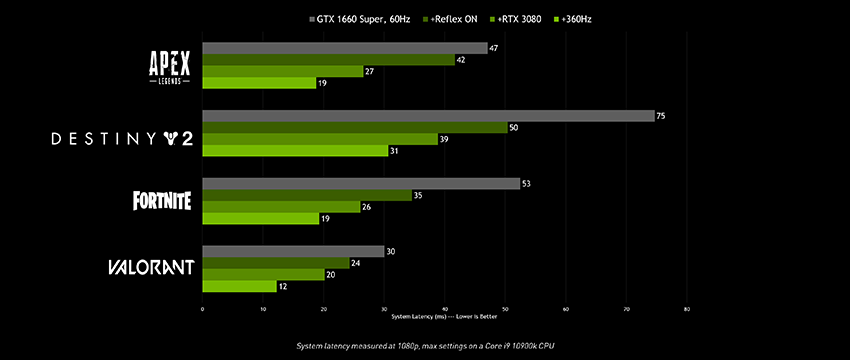Today, 73% of GeForce gamers play competitive multiplayer games, or esports. The most watched esport, League of Legends, drew over 100M viewers for its 2019 championship -- more than last year’s NFL Superbowl. With esports rivaling traditional sports in both viewership as well as playtime, it’s more important than ever for gamers to have their PC and graphics hardware tuned to allow them to play their best. This is why several years ago NVIDIA invested in an esports laboratory staffed by NVIDIA Research scientists, dedicated to understanding both player and hardware performance in esports. Today, we are excited to share with you the first major fruits of this research.
Alongside our new GeForce RTX 30 Series GPUs, we’re unveiling NVIDIA Reflex, a revolutionary suite of GPU, G-SYNC display, and software technologies that measure and reduce system latency in competitive games (a.k.a. click-to-display latency).Reducing system latency is critical for competitive gamers, because it allows the PC and display to respond faster to a user’s mouse and keyboard inputs, enabling players to acquire enemies faster and take shots with greater precision.
NVIDIA Reflex features two major new technologies:
NVIDIA Reflex SDK: A new set of APIs for game developers to reduce and measure rendering latency. By integrating directly with the game, Reflex Low Latency Mode aligns game engine work to complete just-in-time for rendering, eliminating the GPU render queue and reducing CPU back pressure in GPU intensive scenes. This delivers latency reductions above and beyond existing driver-only techniques, such as NVIDIA Ultra Low Latency Mode.
“NVIDIA Reflex technology arms developers with new features to minimize latency in their games. We’re seeing excellent responsiveness and player control with Fortnite running on the GeForce RTX 30 Series.” - Nick Penwarden, VP of Engineering, Epic Games.
“Valorant was designed from the beginning to be a precise, competitive FPS, and that means doing everything we can to ensure crisp, responsive gameplay. With GeForce RTX 30 Series and NVIDIA Reflex technology, we're able to serve players around the world with the lowest render latency possible.” - Dave Heironymus, Director of Technology - Valorant / Riot Games
NVIDIA Reflex will deliver latency improvements in GPU-intensive gaming scenarios on GeForce GTX 900 and higher NVIDIA graphics cards in top competitive games, including Fortnite, Valorant, Apex Legends, Call of Duty: Black Ops Cold War, Call of Duty: Modern Warfare, Call of Duty: Warzone, and Destiny 2.
With popular mid-range cards, like the GeForce GTX 1660 Super, gamers can expect up to a 33% improvement in PC responsiveness with Reflex. Add in a GeForce RTX 3080 and a 360Hz G-SYNC esports display, and gamers can play like the pros with the very lowest latency possible.
NVIDIA Reflex Latency Analyzer: A revolutionary system latency measurement tool integrated into new 360Hz G-SYNC Esports displays from Acer, ASUS, MSI, and Dell, and supported by top esports peripherals from ASUS, Logitech, Razer, and SteelSeries.
Reflex Latency Analyzer detects clicks coming from your mouse and then measures the time it takes for the resulting pixels (i.e. a gun muzzle flash) to change on screen. This type of measurement has been virtually impossible for gamers to do before now, requiring over $7000 in specialized high-speed cameras and equipment.
Whereas in the past gamers had to guess at their system’s responsiveness based on throughput metrics such as Frames Per Second (FPS), Reflex Latency Analyzer provides a much more complete and accurate understanding of mouse, PC, and display performance. Now with Reflex Latency Analyzer, competitive gamers can start a match with confidence, knowing their system is operating exactly as it should be.
Continue reading our NVIDIA Reflex article on GeForce.com
